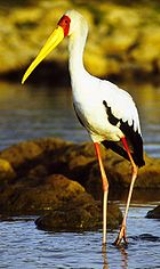
Yellow-billed Stork
Encyclopedia
The Yellow-billed Stork, Mycteria ibis, is a large wading bird
in the stork
family Ciconiidae. It occurs in Africa south of the Sahara and in Madagascar.
Its a medium-sized stork. Length: 97 cm; average body weight for males: 2.3 kg; for females: 1.9 kg. Plumage mainly pinkish-white with black wings and tail; bill yellow, blunt, and decurved at tip. Immature birds are greyish brown with dull greyish brown bill, dull orange face and brownish legs.
The similar Painted Stork
(Mycteria leucocephala) is an Asian bird.
The Yellow-billed Stork is one of the species to which the Agreement on the Conservation of African-Eurasian Migratory Waterbirds (AEWA
) applies.
Bird
Birds are feathered, winged, bipedal, endothermic , egg-laying, vertebrate animals. Around 10,000 living species and 188 families makes them the most speciose class of tetrapod vertebrates. They inhabit ecosystems across the globe, from the Arctic to the Antarctic. Extant birds range in size from...
in the stork
Stork
Storks are large, long-legged, long-necked wading birds with long, stout bills. They belong to the family Ciconiidae. They are the only family in the biological order Ciconiiformes, which was once much larger and held a number of families....
family Ciconiidae. It occurs in Africa south of the Sahara and in Madagascar.
Its a medium-sized stork. Length: 97 cm; average body weight for males: 2.3 kg; for females: 1.9 kg. Plumage mainly pinkish-white with black wings and tail; bill yellow, blunt, and decurved at tip. Immature birds are greyish brown with dull greyish brown bill, dull orange face and brownish legs.
The similar Painted Stork
Painted Stork
The Painted Stork is a large wading bird in the stork family. It is found in the wetlands of the plains of tropical Asia south of the Himalayas in South Asia and extending into Southeast Asia. Their distinctive pink tertial feathers give them their name. They forage in flocks in shallow waters...
(Mycteria leucocephala) is an Asian bird.
The Yellow-billed Stork is one of the species to which the Agreement on the Conservation of African-Eurasian Migratory Waterbirds (AEWA
AEWA
The Agreement on the Conservation of African-Eurasian Migratory Waterbirds is the largest of its kind developed so far under the Bonn Convention. It was concluded on 16 June 1995 at The Hague, the Netherlands and entered into force on 1 November 1999 after the required number of at least fourteen...
) applies.

